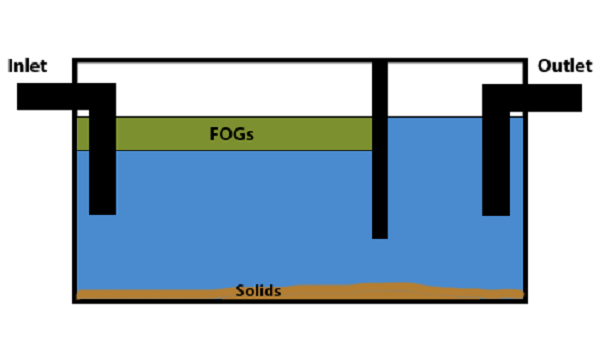
Fried foods tend to smell pretty tasty, but rancid FOGs (Fats, Oils and Grease) rarely do. Because of this, trapping grease in a box and leaving it there for it to go off may not seem like such a good idea, at first. Those first thoughts can make some forget the environmental benefits and put off investing in a grease trap.
But, those first thoughts are wrong. Here’s how to avoid the grease trap stink problem.
First, let’s go over the basics:
How Do Grease Traps Work?
Most grease traps look pretty simple: a box with a pipe feeding in and a pipe feeding out. They are found in the midst of a food business’ drainage pipes, usually in a back room (where the dish-washing goes on), either visible, above ground, or neatly tucked away beneath a manhole cover.
Grease traps can come in several different sizes. The more FOGs a business produces, the bigger the grease trap they will need: a chicken and chip shop will need a bigger trap than the raw-vegan eatery down the street.
Grease traps are designed to give the hot greasy water which you pour down your plughole a chance to cool. As that greasy water cools, the oils in it solidify and float to the surface.
Many grease traps are designed with a grease separation chamber which (you guessed it) keeps this surface layer of solidified FOGs separate from the rest of the water. Many grease traps also contain a sludge trap which catches all of the solid bits of food which sink to the bottom of the box. The water, in the middle, then continues on its journey to the sewers.

Now: What Makes the Trap Stink?
With those layers of FOGs and solid food sludge separated out, ever-present and ever-hungry bacteria get to work. The worst of the smell actually comes from the decomposition of the solid food deposits at the bottom of the grease trap: this is the layer which will cause bacteria to release pungent nitrates and rotten-egg-smelling sulphates as they digest it.
Luckily, grease traps are fitted with pretty good seals which tend to hold back most, if not all, of these odours.
But, if the smell is too strong to be held back…
What Can You Do About It?
While trying to kill the bacteria in your trap by pouring gallons of disinfectant down your drains may sound like a simple solution, there’s nothing better than simply cleaning your grease trap out regularly.
How regular “regularly” is will depend largely on the size of the grease trap in question: the smaller the grease trap, the faster it will fill up. While some need emptying every week, others can go three months without being drained.
Even better, get an expert to clean your trap out for you. While some types of traps, such as automatic grease traps, are designed to make it easy for you to dispose of your FOGs yourself, going for a larger stainless-steel trap and employing a professional can be a sensible step further for a bigger food business.
Not only will this spare your unluckiest member of staff some dirty work, you can rest easy knowing that your trap is in safe hands: no parts will be misplaced or replaced incorrectly and, in the long term, your chosen professional can keep an eye on how the trap is working (checking the seals for wear and tear which may make them faulty, for instance).
Looking after your grease trap well will help it look after our sewers. Most grease traps begin to lose their efficiency once they are a quarter-full: after that, FOGs begin to slide right through. So, keeping your grease trap clean and maintained in full working order will not only save you from the smell, it will help to save our planet from this slimy pollution.

Leave a Comment
Your email address will not be published. Required fields are marked *